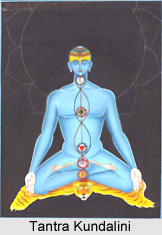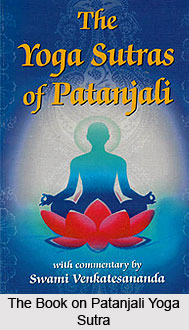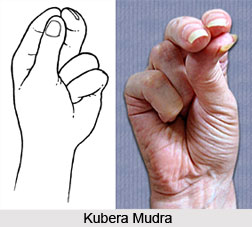Jnana Yoga is considered as the highest form of Yoga and is based on the path of knowledge. It is an important process in the sadhana for moksha. Its goal is `atma saksatkara` or the direct vision of the true nature of self (jivatman). It serves as an important means to Bhakti Yoga. After an aspirant for moksha has successfully completed the practice of Karma Yoga he can undertake Jnana Yoga. A jnana yogi cannot avoid the practice of Karma Yoga. Jnana Yoga requires concentration of mind and it cannot be obtained without the observance of prescribed religious duties.
Meaning of Jnana Yoga
Jnana refers to wisdom or knowledge. There is a wide difference in the theories advanced by the Advaita Vedanta and Visistadvaita regarding Jnana Yoga due to the different ontological positions held by the two schools of thought. According to the Advaita, jivatman is not a distinct real entity other than Brahman and the two are identical. Owing to avidya, the cosmic ignorance, the forms appear to be many and as different from Brahman. The ignorance of the true nature of Brahman is the cause of bondage and its removal is possible only by knowledge of the true nature of Brahman. In Advaita, self-realization is actually the same as Brahman-realization. It is this realization of the identity of the jiva and Brahman as taught in the Upanishadic text "Thou art that" (tat tvam asi) that removes bondage. The removal of cosmic ignorance by Brahman-knowledge is moksha or the liberation from bondage. Self-realization which is the same as Brahman-realization is thus the goal of the spiritual discipline (sadhana). The nididhyasana or meditation according to the Advaitin serves as an aid to Jnana Yoga.
The Visistadvaitin holds a diametrically opposite view. Jivatman is a real entity distinct from Brahman. Both are absolutely real and are different from each other. Bondage is caused by karma in the form of merit and sin arising from the performance of good and bad deeds. Its removal is possible only through the grace of God for which purpose Bhakti Yoga or upasana in the form of unceasing meditation on God with devotion is to be performed. Bhakti Yoga needs the aid of both Karma Yoga and Jnana Yoga. Atma-saksatkara which is the aim of both helps to achieve Brahma saksatkara or attainment of Brahman. In the light of this explanation, Jnana Yoga in Visistadvaita refers to the unceasing meditation on the true nature of the atman of an individual after he has achieved control over his mind and senses. Vedanta Desika describes it as nirantara atma cintanam which means constant meditation on the true nature of the self (atman). The purpose of the meditation on the self is to obtain the direct vision of the self (atmavalokana) which in turn helps to achieve the direct saksatkara or realization of God by means of Bhakti Yoga.
 Practice of Jnana Yoga
Practice of Jnana Yoga
The practice of Jnana Yoga for the purpose of atmavalokana requires the strict observance of the yoga practice (yogabhyasa) as described in the Bhagavad Gita. In a broad sense, it comprises the eightfold moral and spiritual discipline (Ashtanga Yoga) of the Yoga system. In the first place, the aspirant needs the concentration of mind. In order to secure the steadiness of the mind, the impurities of the mind in the form of rajas and tamas and other unethical qualities such as kama (passion) and krodha (anger) have to be eradicated by the observance of prescribed religious acts. This means the scrupulous observance of all the mandatory religious duties. In other words, the observance of Karma Yoga is imperative for the success of Jnana Yoga.
The control of sense organs and development of the spirit of detachment (vairagya) are also needed for the practice of Jnana Yoga. The mind and sense organs have a natural tendency to flow outwardly and attract the individual towards worldly pleasures. These are the obstacles coming in the way of the practice of yoga and have, therefore, to be totally overcome.
There are a few other requirements which are common to all kinds of meditation such as the selection of a quiet and suitable place, need to sit in a steady posture, control of breath, restriction on diet etc. Obstacles are bound to arise in the way of yogic practice and in order to overcome them, the Gita advocates that one should seek the grace of God by meditation upon Him. With the fulfilment of all these requirements an aspirant should practise the meditation upon the jivatman over a long period. This will ultimately lead to the direct vision of the self (atmavalokana), which is the goal of Jnana Yoga.
Stages of Jnana Yoga
The atma saksatkara or self-realization comes gradually in stages. In the initial stage, the constant and unceasing meditation upon the self gives him the philosophic insight about the true nature of the self, viz., that the self is essentially of the nature of jnana and ananda and that all selves are of the same character. This helps to develop an attitude of looking upon all living beings as equal in so far as their intrinsic nature is concerned. Thus says the Gita: "The wise men regard as equal a person blessed with knowledge and humility, an ordinary Brahman, a cow, an elephant, a dog and an outcaste." The difference between one living being and another is all due to the physical bodies they assume on account of karma.
In the next stage, he realizes that Ishwara or God is immanent in the soul and that the individual selves are supported, controlled and are intended for the service of Paramatma.
At the next stage, when he gets the direct vision of the self, he enjoys the blissful character of the self and becomes absorbed in the joy of this spiritual experience, which is the culmination of Jnana Yoga. This state of the experience of the unique spiritual bliss is regarded in the Samkhya yoga system as kativalya or the state of self in its own true nature (kevalavastha), devoid of all external experience. This state itself is liberation (moksha) for the Samkhya and Yoga.
However, according to the Visistadvaita Vedanta, this is not an end in itself but only a means to God-realization. It is not a goal because in the state of kativalya the individual self, though it becomes free from bondage, does not experience the bliss of Paramatma. It, therefore, advocates the practice of Bhakti Yoga or the meditation on God as the next step from the stage of Jnana Yoga. The ananda or bliss derived from the paramatma saksatkara is far superior to the bliss obtained from atmavalokana. Thus, Jnana Yoga is a subsidiary means to Bhakti Yoga, which alone is the direct means to moksha.




















